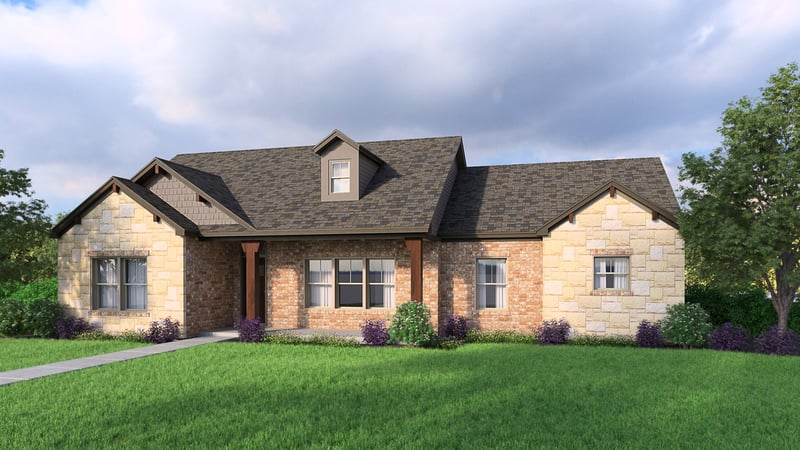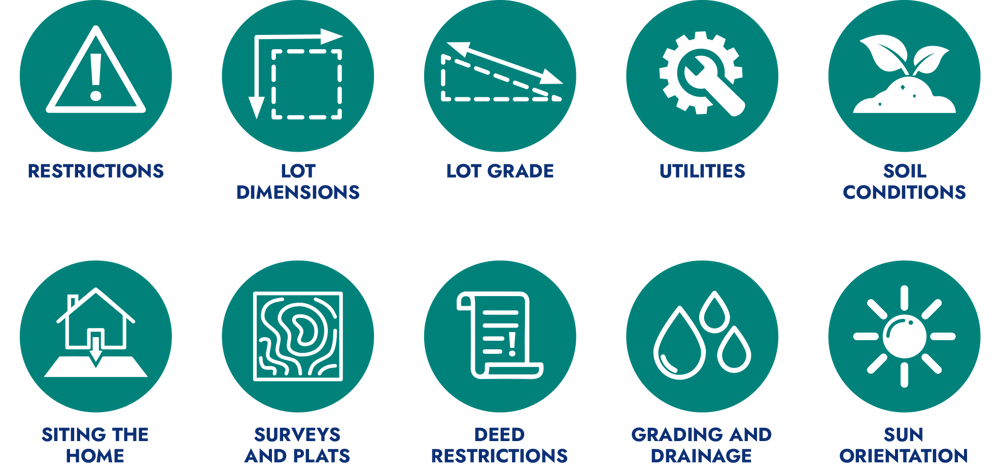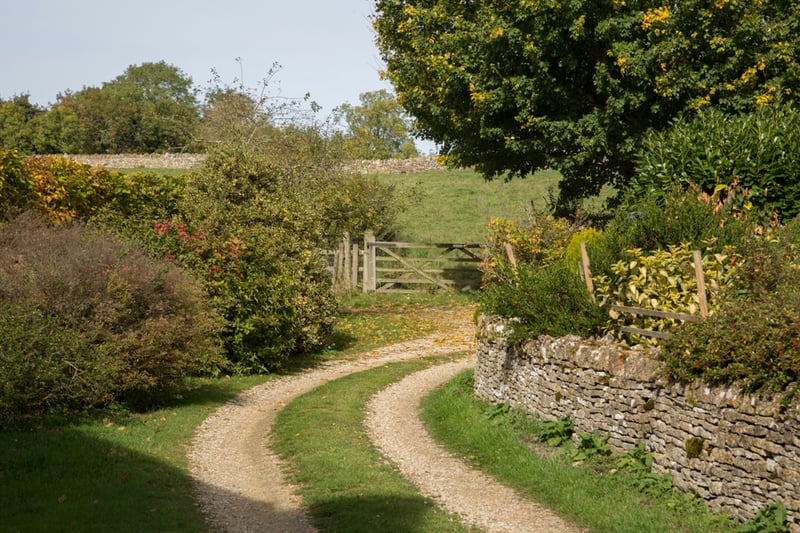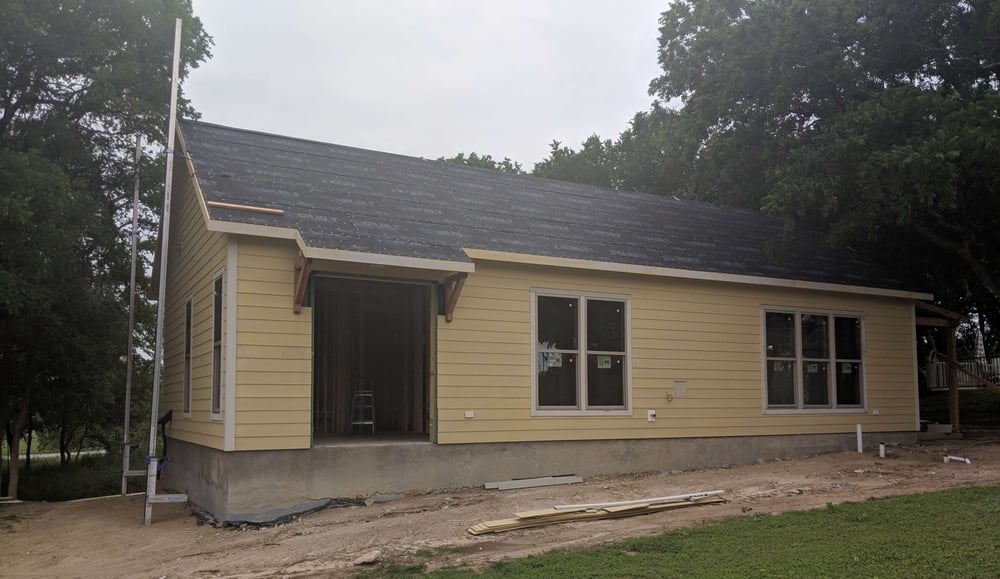By: Brian Carlin
There are a lot of great places to build a house in Texas - whether you are looking for a place near one of Texas’s many major cities (Fort Worth, Dallas, Houston, Austin, San Antonio) or somewhere outside the city, like many of the cities where we build custom homes in Fort Worth and the surrounding western region.
Texas is a great place to live. Building a custom home in Texas is affordable - not to mention you can usually find a good amount of land to build on depending on where you buy your lot. Learn more about how much it costs to build a house in Texas.
This guide will walk you through a few things to keep in mind as you buy a lot and build a house in Texas - from conducting a basic assessment of the land you want to buy to finding the best places for building a home in North Texas to dealing with problems that may arise on land you already bought.

Choosing land to buy for your custom home isn’t as easy as you might think. Working with a local real-estate agent or someone who can help you properly evaluate the location is ideal, but if you are going to purchase the property lot on your own, there are several things to know when buying land in Texas that could influence the total cost of building your new home.
You can learn more about specific laws and restrictions for building on your local city’s website, as well as what permits are needed to build a house in that area.
Here are some common factors you'll need to consider for your land, no matter where you decide to build:

 RESTRICTIONS
RESTRICTIONSWhat are the lot restrictions for my new property? Will it affect what I can build?
If you’re looking in a platted subdivision, these lots will usually have restrictions placed upon them that restrict what you can build.
Some restrictions may include:
The deed restrictions may require that all homes be 2,000 square feet or larger, built of brick or stone, with 20% siding or less. They may also tell you if barns or shops are allowed, whether you can park boats or travel trailers and what kind of animals you can keep on your property. It is not uncommon for two properties directly across the street from one another to have different sets of restrictions, or for one to have them while the other does not.
Zoning ordinances exist within most city limits, which govern what can be built on a property and how it can be used. The building types and formats allowed in a zoning category are typically detailed in a lengthy document.
Some municipalities also have various ordinances that govern decisions, such as where you can place your house and fence (and what type of fence you can build) and the width of the drive approach or city sidewalk requirements.
These ordinances don’t always agree with the city zoning ordinance.
Extraterritorial jurisdictions are not technically in the city but they still have access to some city services and are under some jurisdiction by that city.
So in Fort Worth’s ETJ permits aren’t required (though we still inspect everything), but the city planning and zoning department still manages the platting process for new parcels.
In the country, subdivision requirements and restrictions—while far less stringent than city requirements—have lot-size minimums and other restrictions for water quality and platting.
 LOT DIMENSIONS
LOT DIMENSIONSHow big is the lot for your new house? Is it as big as you think or are there additional factors to consider?
Make sure your site has plenty of buildable width and depth and take into account property line setbacks, utility easements, city rights of way, drainage paths and driveway entrances and parking pads. Check with the local building and zoning office to verify these factors.
 LOT GRADE
LOT GRADEDoes the lot for your new house slope or is it relatively flat?
Most property sites have some slope to them, and it can be deceiving to look at with the naked eye. To the extent the site slopes, excavation and grading may be required to level the pad site for construction. If so, factor in costs to fill in dirt and rent a tractor or roller.
In general we estimate one load (one cubic yard) of select fill for every 300 cubic feet of pad site that needs to be built. A typical pad side on a site that slopes about a foot across the surface might require 10-20 loads of fill.
A site with 18” - 24” of slope might require 20-30 loads. And so on.
To accurately estimate the volume of fill dirt required, we use a laser level to take point elevations across the pad site and run calculations.
 UTILITIES
UTILITIESDoes your lot have utilities already or will you need to extend power, water, gas or sewer lines to the lot?
Our initial estimate will assume all utilities are located within 30’ of the building pad and are supplied with taps. However, this often isn’t the case, so we walk our clients through a detailed assessment of site development costs early in the process.

|
| Electrical Power The first thing to note is if your site has power service established. If not, does it have a transformer nearby—either pole-mounted or in-ground? If you don’t know, call your local electric delivery company. This is sometimes not the same company that you purchase electricity from. They will have a budget established for new service, including the amount of lateral line. If you want the line to run underground, be sure to ask about any additional cost to trench and run the line to the service panel on the house. |
|
Sewer Service Many rural sites will not have municipal sewer systems and will rely on septic or aerobic treatment systems. Septic systems are traditional leach systems that do not require power, motors or pumps; they rely on gravity and natural digestion to break down waste and leach into a field. However, some soil cannot properly support the leaching process, so an aerobic system may be required. A simple percolation soils test is performed by a licensed inspector to determine the soil and system type you require. Sandy soil will generally allow water to pass through it sufficiently, but soil with lots of clay content will not. An aerobic system is designed where soils will not properly percolate, or where the leach field is too small. The aerobic system has an added disinfectant process, and then it sprays the water in fine droplets over a smaller leach field, further disinfecting it as it aerates. The resulting layer of treated waste is tested and deemed safe; it will not smell like waste and is not dangerous for animals or children. |
|
Water Service Is there an existing meter, or is water service available at all from a city or co-op provider? If not, you’ll need to budget for a well. Call a local well provider (we can usually help you find one) and ask them how deep the wells typically are in that area. A typical well will cost anywhere from $7,000 - $10,000, but it depends heavily on the location. |
 SOIL CONDITIONS
SOIL CONDITIONSWhat type of soil does your lot have and what is the amount of growth from trees and brush?
The type of soil and amount of growth will impact the cost of lot clearing and compacting your pad site for construction, as well as the type of foundation suitable to your site.
Every owner should have a soils test performed prior to designing a foundation to ensure the plan is suited to your site. Homesites with active soils (which describes most sites in North Texas) will require sturdier foundations with deeper beams, more steel reinforcement and more concrete, and some will require concrete piers. The geotechnical report will specify criteria that the foundation designer will use to design key parts of the foundation.
The engineers want to know how much the soil will move when water is introduced and when it dries out. And they can determine what layers are below the surface. Sometimes rock is not far below the surface, for example.
The top layer of grass is always scraped off and discarded first to remove any growing material from the site. Any trees growing within 10’ or less of the foundation should be removed, as well, so that the roots do not absorb water from underneath the slab and create dry areas where soil can shrink.
 SITING THE HOME
SITING THE HOMEAre there stipulations for where you can sit the house on your lot?
If you have neighbors nearby, you can get a general idea by looking at how far their homes sit from the street and their property borders to get a general idea of where your house might sit. However, you’ll need official records, such as the property plat (if there is one), deed restrictions or applicable development ordinances to verify any setback requirements.
During our initial site evaluation, we will help you think through locating your home on the site to take full advantage of the property characteristics.
Are there creeks, rivers or lowlands nearby? Is there a floodplain on the property? Buildings located in a floodplain must be raised out of it with extra grading or the property will cost more to insure against flood.
Keep in mind: Where you set your home on the site will determine the amount of paving your home requires. The further back from the street you set it, the longer the driveway will be. We have set some homes ½ mile off the road, which means ½ mile of road to get to the home site.
 SURVEYS AND PLATS
SURVEYS AND PLATSHas the boundary survey for your lot been updated? What are the property lines?
A good first step to site planning is making sure you have an up-to-date boundary survey. The survey will show the actual location of the property pins, any improvements, the lot dimensions and any easements or utility line locations. The plat, if there is one, is filed at the county clerk’s office and shows the lot as originally designed and recorded, and it will often show the front building setback.
 DEED RESTRICTIONS
DEED RESTRICTIONSAre there any deed restrictions that have been recorded that could affect your ability to build your home?
These documents are filed on record in the city or county clerk’s office and will show you any restrictions that may have been placed on the property by a previous owner.
When you purchase a piece of land, the title company will usually pull the plat and deed restrictions, if available, and the title commitment will contain a Schedule C reflecting any mineral interests, property liens, easements granted or title encumbrances.
Sometimes owners grant permission for others to access their property, maybe for farming or ranching purposes, or for oil or gas equipment servicing. You can’t build in these easements and there may be reasons to stay away from them.
 GRADING & DRAINAGE
GRADING & DRAINAGEHow does the water drain across the property? This is incredibly important for your new home build.
The most important aspect of siting a home is dealing properly with water drainage. You need a level, compacted pad site, and after the foundation is poured, you will come back to grade the site so that the dirt falls away from the foundation and carries the water away into proper drainage swales.
The amount of slope to the site can have a big impact on the cost of the foundation. Slope is difficult to gauge accurately by the naked eye. In order to get solid budget numbers, it is necessary to use a laser level to collect grade elevations and determine the amount of fill needed to level the pad site.
Sometimes the slope of the land is severe enough to require retaining walls, in order to reduce the slope of the yard and maintain usable yard.
 SUN ORIENTATION
SUN ORIENTATIONHow will the sun hit your home? This can affect your views, as well as your energy bills.
The direction your home will face has a big impact on your views, sunlight and energy bills. You cannot always control the orientation, but you can control other elements like your floor plan, where important rooms are located and whether you need a deep porch or patio to provide shade.


There are a lot of different factors to consider when choosing where to build your home in North Texas, especially a custom home that has everything you’re wanting. Odds are, you’ll want to stay there a while.
As you consider where to purchase your lot, let’s look at where people choose to build in North Texas and why they believe these to be the best places to build a house in Texas.
And if you’re moving to North Texas for the first time, you can learn more about the area here.
More people are choosing to live in rural Texas outside of large cities instead of within the cities themselves. Why is this? There are a couple of reasons why people choose to live in rural areas, especially in North Texas:
A lot of people want more land when they build a house. They want room for a garden, room for the kids to play, space between their house and the neighbor’s house, etc. Building a house in rural areas is great for acquiring more land.
Along with these open spaces is fresh air, a chance to see the stars, a view to watch the sun rise and just get back to nature. People enjoy getting away into the countryside from time to time, but some people are choosing to make this a more permanent part of their life.
If you’re looking to slow down and get away from the busyness of city life, settling down in a rural setting may be just what you need. These areas often have a slower pace and more peace and quiet than you would find living in the city.
While we said before that living in rural areas allows you to live farther from your neighbors, it’s also a great place to be a part of tight-knit communities. Rural towns have smaller populations than larger cities so most people who live in these areas know one another. If you are looking for a community like this, then choosing to build here is a good option.
More people are looking for cleaner ways of living, away from city pollution and over-processed foods. Rural areas allow for cleaner air and the opportunity to farm and produce your own food, if you’d like. You won’t have to worry about city ordinances or laws surrounding the number of chickens you’re allowed to have in the countryside.
Another benefit of rural living is the affordable cost of living.
Living in the countryside isn’t without its downsides though. Here are some of the benefits of city living.
You can find places close to work by choosing to live in the city so you can have shorter commutes. But in the year 2020, with so many people learning to work from home, this may not be much of an issue—as long as you have good Internet.
City living often means more activities and events throughout the year. These are great places to meet new people.
Living in the city helps you be more easily or readily connected via your phone or the Internet than you might be in rural towns.
Urban living offers quick access to grocery stores, fast food, repair services and more.
One of the benefits of urban living, especially if you have kids, is more options for school.
If you find a custom home builder you really like and are open to where you build your new home, check to see where they build homes before purchasing your lot.
At Hedgefield Homes, we build homes in both rural and urban areas of North Texas, primarily surrounding the Fort Worth metroplex. You can see a full list of where we build on our website and some of the North Texas counties we focus on listed below:
|
||
|
|
|
|
|
Weatherford
|
Azle
|
Burleson
|
|
|
|
|
|
Granbury |
Paradise |
Mineral Wells |
|
|
|
Hill County |
|
Nemo |
Bluff Dale |
Lake Whitney
|
|
||
|
Ellis County |
|
|
|
Maypearl |
|
|
|
|
|
|

It is always best to get the advice of a trusted builder before purchasing a site; however, if you’ve already purchased, the next best thing is having the builder out before the home design is performed to help you develop the site affordably.
Talk to your home builder about any property problems you might be facing. Many buyers often underestimate the degree of slope in the ground on a piece of property. Fortunately, there are usually creative solutions to land issues, and other property problems you may encounter.
This house (pictured above) needed to be built in a natural drainage area, which meant building the foundation up about 5 feet in the back and regrading around it.
What Are Common Mistakes People Make When Building a Home that I Should Know Before My Home Build?
What Is the Preconstruction Process of Custom Home Building?

We Believe Your Home Should Improve Quality Of Your Life. It Should Be Efficient, Built To Last, And You Should Love Being In It. Hedgefield Homes Designs, Builds And Remodels Homes That Do These Things.
410 Shops Blvd, Suite 200, Willow Park, TX 76087

410 Shops Blvd, Suite 200
Willow Park, TX 76087